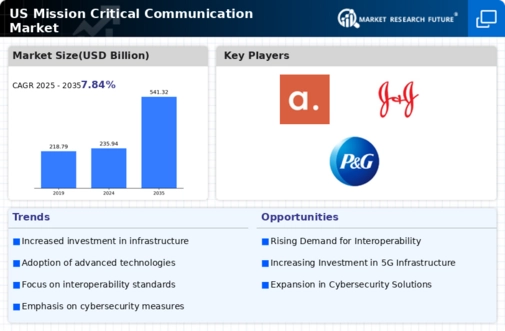Emerging Cybersecurity Threats
As the mission critical-communication market evolves, the threat landscape is also changing, with emerging cybersecurity threats posing significant challenges. The increasing reliance on digital communication systems makes them vulnerable to cyberattacks, which can disrupt critical operations. Organizations are thus compelled to invest in robust cybersecurity measures to protect their communication networks. The market for cybersecurity solutions in this sector is projected to grow by 15% annually, reflecting the urgent need for enhanced security protocols. This focus on cybersecurity not only safeguards sensitive information but also ensures the integrity of communication systems during emergencies, thereby maintaining public trust.
Growing Focus on Public Safety Initiatives
Public safety initiatives are playing a pivotal role in shaping the mission critical-communication market. Governments at various levels are increasingly prioritizing funding for communication infrastructure that supports emergency services. This focus is evident in the allocation of federal and state budgets, with billions of dollars earmarked for upgrading communication systems. For instance, the Federal Communications Commission has proposed initiatives to enhance communication networks for first responders, which could lead to a market expansion of approximately $1 billion by 2026. Such investments are essential for ensuring that emergency personnel have access to reliable communication tools, ultimately improving response times and saving lives.
Regulatory Changes and Compliance Requirements
Regulatory changes are influencing the mission critical-communication market, as agencies must comply with evolving standards and guidelines. These regulations often mandate the adoption of advanced communication technologies to ensure public safety and operational efficiency. For example, the Federal Communications Commission has implemented new rules aimed at improving the reliability of emergency communications. Compliance with these regulations can drive investments in new technologies, with estimates suggesting that the market could see an influx of $500 million in funding for compliance-related upgrades. This regulatory environment encourages innovation and ensures that communication systems meet the necessary standards for effective emergency response.
Increased Demand for Interoperability Solutions
Interoperability among various communication systems is becoming increasingly vital in the mission critical-communication market. As agencies and organizations utilize different technologies, the need for seamless communication across platforms is paramount. This demand is driven by the necessity for coordinated responses during emergencies, where every second counts. The market for interoperability solutions is expected to grow significantly, with estimates suggesting a CAGR of 10% over the next five years. This growth reflects the urgency for systems that can integrate diverse communication tools, thereby enhancing collaboration among first responders and improving overall public safety outcomes.
Technological Advancements in Communication Systems
There is a surge in technological advancements in the mission critical-communication market, particularly in the development of next-generation communication systems. Innovations such as 5G technology and enhanced satellite communications are enabling faster and more reliable data transmission. This is crucial for emergency services and public safety organizations that rely on real-time information. According to recent data, the market for 5G infrastructure is projected to reach $300 billion by 2025, indicating a robust investment in communication technologies. These advancements not only improve operational efficiency but also enhance the overall effectiveness of mission critical communications, ensuring that first responders can communicate seamlessly during emergencies.














Leave a Comment